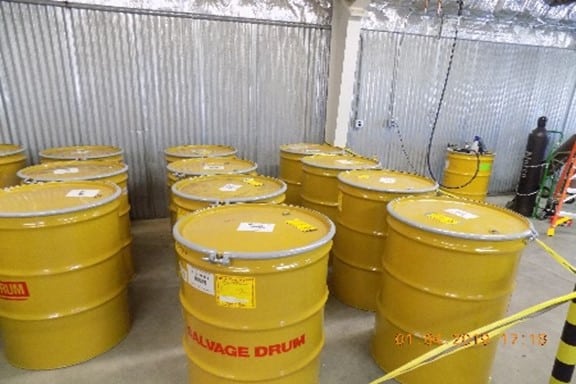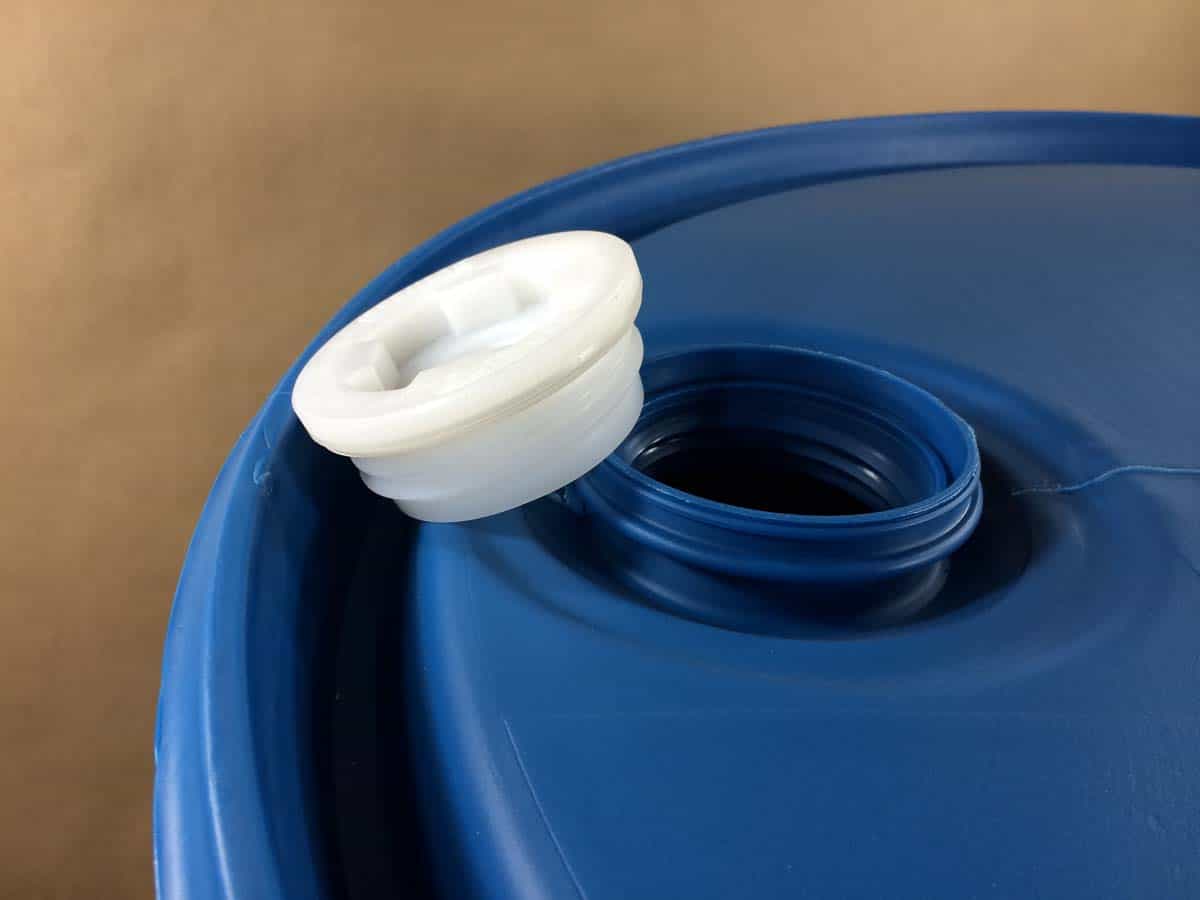A Near-Miss: Unexpected Positive Pressure in Drum During Lid Removal

Eighty-five gallon type A drums
A Near-Miss: Unexpected Positive Pressure in Drum During Lid Removal
Unexpected positive pressure in an empty 85-gallon type A drum was discovered while removing the lid as part of a required security inspection prior to receipt into the facility. Two mitigative measures have been put into place for all future inspections of this kind. Read more to learn the whole story.
What happened?
On June 26, 2019, at approximately 2:30 PT, three operators were performing a work function in which several empty 85-gallon type A drums were required to be opened for security inspection prior to receipt into the facility. One of the three operators was opening a drum using hand tools, loosening a bolt and ring around the lid of the drum. Prior to the bolt being completely removed from the drum lid ring, pressure inside of the drum caused the lid and drum ring to break free from the drum in an upward motion, sending the lid approximately 7 feet in the air from ground level, then landing back on the ground. No contact was made to the operator.
Previous facility experience with opening empty drums was identified as having negative pressure, making the lid more difficult to remove. The operators continued opening the remaining drum lids for inspection.
What could have been done differently during the opening of the drums?
Two mitigative measures were identified during the fact-finding process that could be used in this application, going forward:
-
- Remove the bung (or buttress) plug before the locking ring is loosened, allowing internal pressure to equalize with the outside;

2. Use a strap/sling that fits over the drum lid and is strapped to the drum body to restrain the lid.
What issues caused the near-miss?
- Drum lid and ring pops off as a result of the pressure in the drum.
- Workers did not pause or take a time out.
- Work was assumed to be low risk and covered as a performer controlled activity,* however, performer-controlled activities deal with moving and handling of drums but does not identify the pressure hazard when removing drum lids.
- Safety barriers available not known or used.
What are the Lessons Learned?
What can we take away from this near-miss? Better use of core HPI tools, including:
- A Questioning Attitude – Supervisor’s previous experience was with lower than atmosphere pressure in the drum. Question what could potentially go wrong even with routine or simple jobs.
- A Pre-job Briefing – During pre-job brief, spend time discussing routine activities, work control, and encourage discussion about past experience and hazards that may be present for this type of work.
- Stop When Unsure – When an unanticipated outcome occurs during a job, step back and examine: why the outcome occurred, are the hazards properly mitigated, management notifications.
*Performer-Controlled Activity: Those activities where all associated hazards are recognized and mitigated through the skills and/or physical techniques acquired by the performer through training (general or specific), mentoring, or on-the-job training over time for a specific discipline or activity.
This Lesson Learned (INL-2019-0028) was published by OPEXSHARE Department of Energy and was shared from the Idaho National Laboratory Operating Experience Program, Idaho National Laboratory, Idaho Falls, Idaho.
Founded in 1988, the TapRooT® Root Cause Analysis System solves hurdles every investigator faces
TapRooT® Root Cause Analysis Training System takes an investigator beyond his or her knowledge to think outside the box. Backed with extensive research in human performance, incident investigation, and root cause analysis, TapRooT® is a global leader in improved investigation effectiveness and productivity, stopping finger-pointing and blame, improving equipment reliability, and fixing operating problems.

System Improvements, the creator of the TapRooT® System, has a team of investigators and instructors with years of extensive training ready to offer assistance worldwide. We also offer ongoing support to our clients through free newsletters and root cause tip videos, the root cause analysis blog, and our annual Global TapRooT® Summit.
Register for a TapRooT® Root Cause Analysis Training Course
NOTE: Because of current corporate and governmental travel restrictions, social distancing policies, governmental regulations, and overall concern of the virus, we are CANCELLING all courses in North America through the end of May, and some into the early summer months. We hope this will allow enough time for the virus to subside and our clients to recover.
Of course, our staff and technical support team are working during this time. Feel free to connect by phone (MAIN: 865.539.2139; SUPPORT: 865.357.0080) or EMAIL.
We look forward to teaching COURSES as soon as possible. In the meantime, we also offer ongoing support to our clients through free NEWSLETTERS, root cause tip VIDEOS, and the Root Cause Analysis BLOG on our WEBSITE.
Please see our Covid-19 full STATEMENT.
TapRooT® Root Cause Analysis Training courses are taught all over the world. If you are interested in learning how to stop repeat incidents, find a 2-DAY or 5-DAY course. We are available to train you and your staff on-site at your workplace; CONTACT US to discuss your needs. You may also call us at 865.539.2139 for any questions you may have.
Keep in Touch to Improve Your Problem-Solving Skills
We’re continually training, helping you improve your professional root cause analysis skills. Stay current with your TapRooT® Root Cause Analysis skills and training by:
- Following our blog;
- Tuning in to TapRooT® TV Video Sessions or our podcasts;
- Connecting with us on Facebook, Twitter, Instagram, Pinterest, LinkedIn, and YouTube.



